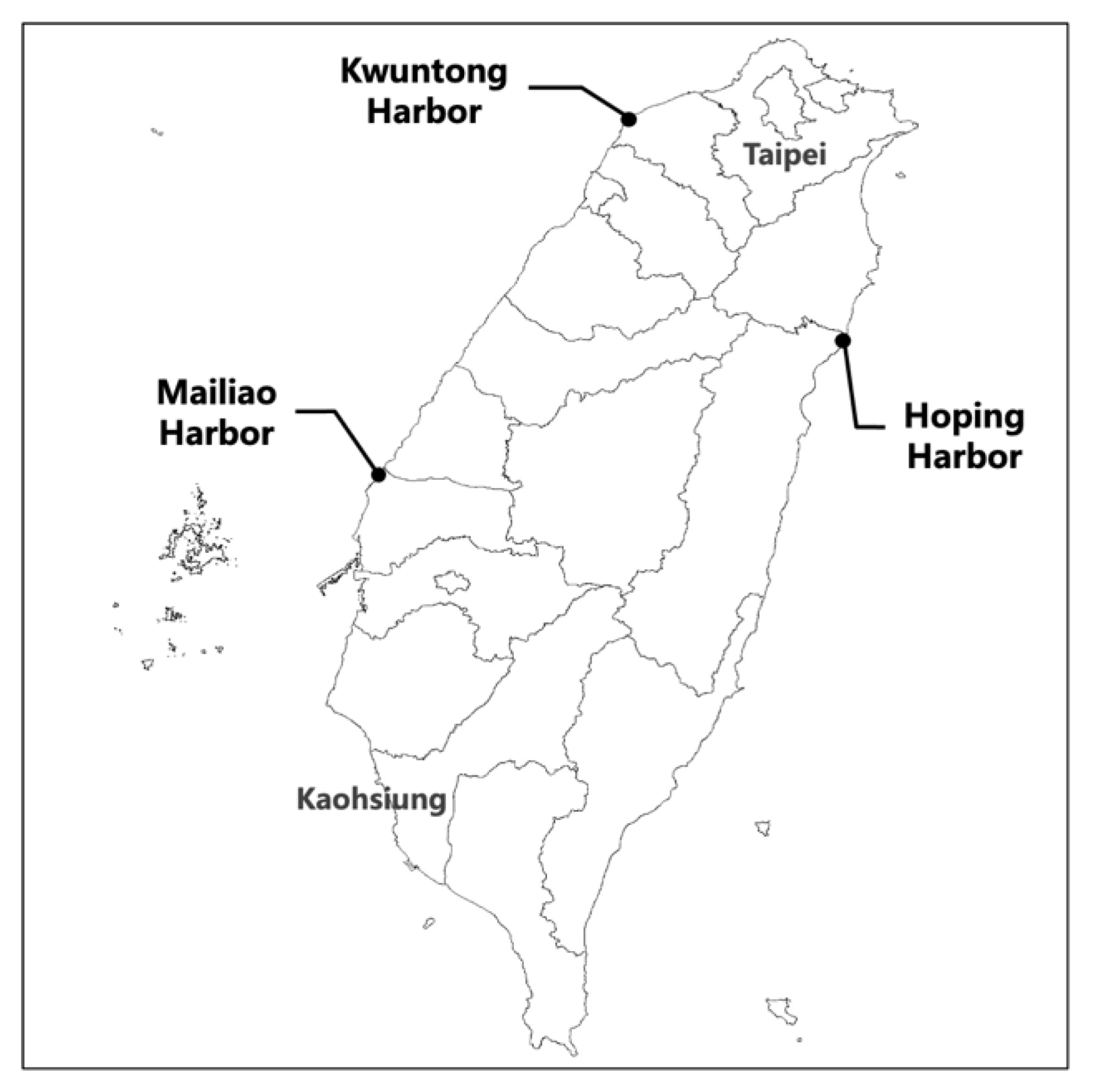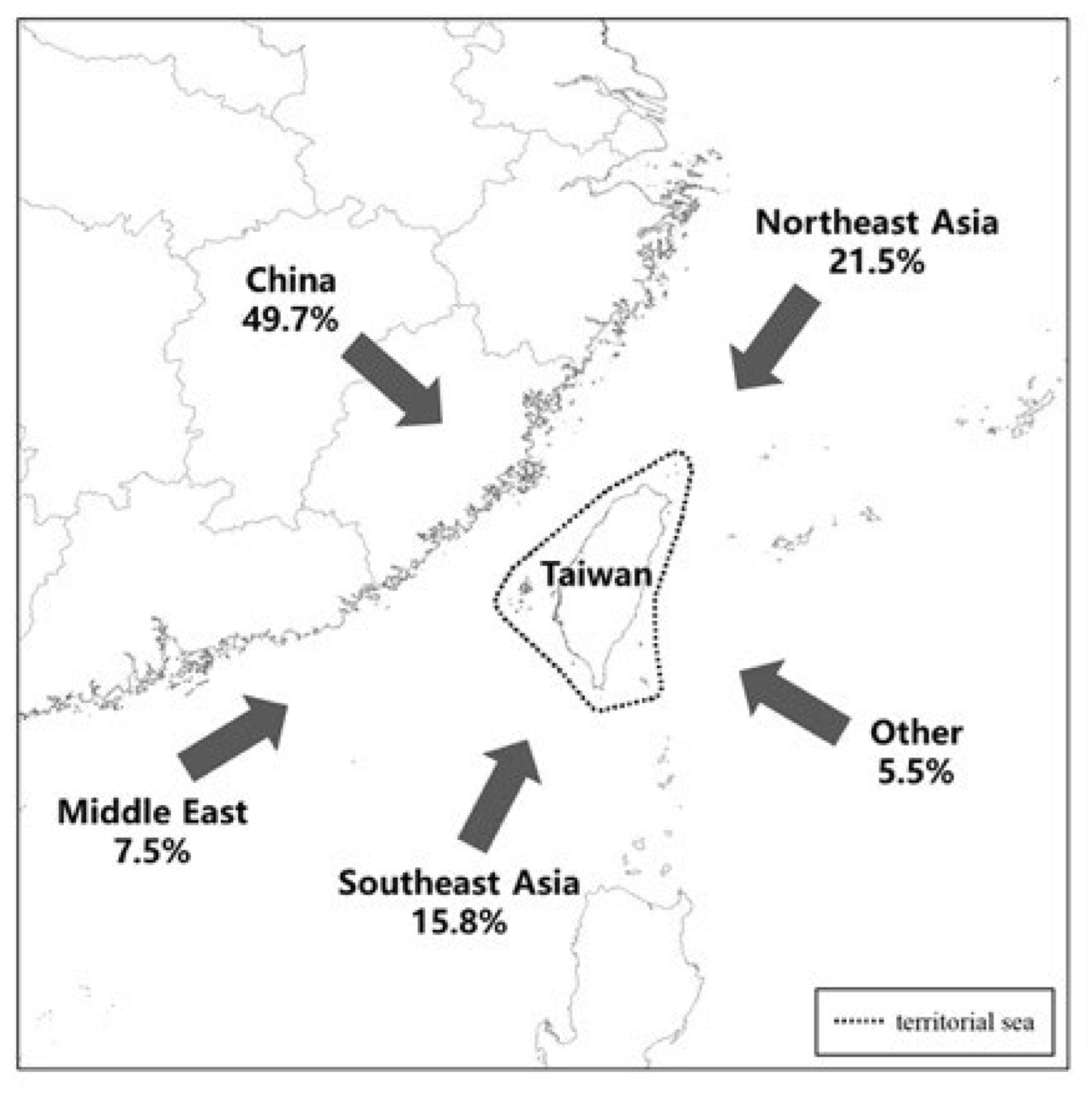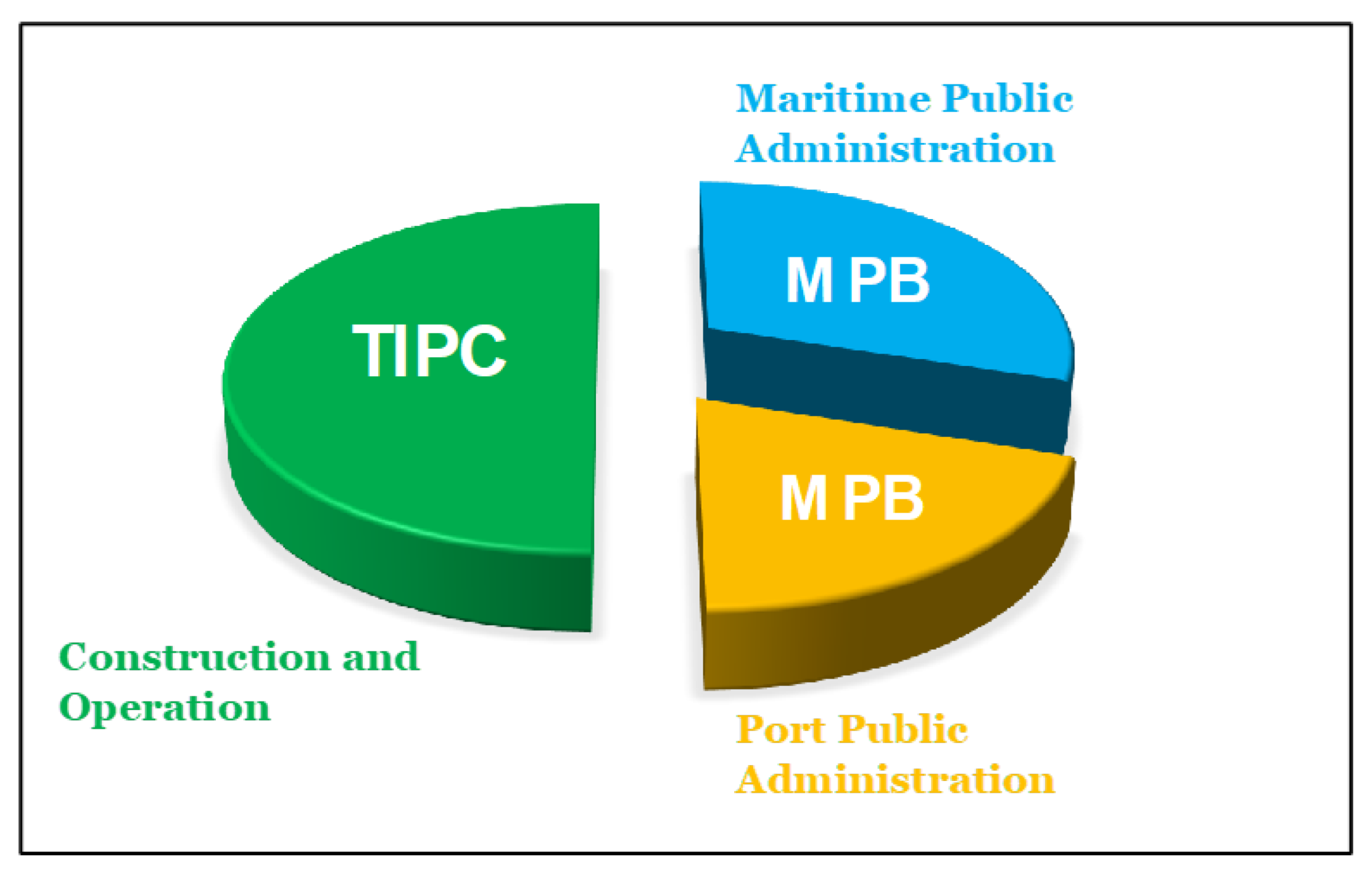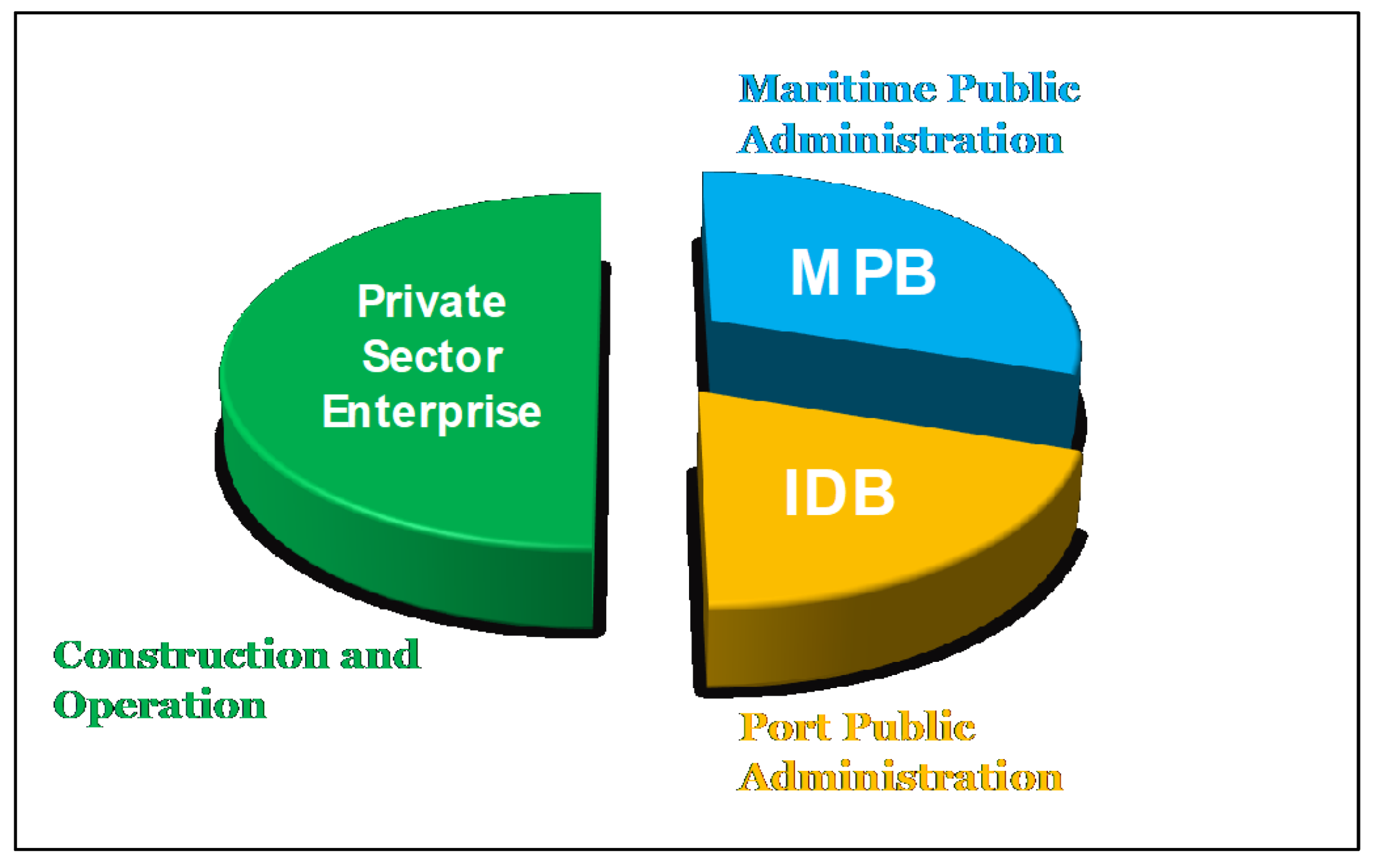The Study on the Ballast Water Management of Mailiao Exclusive Industrial Harbor in Taiwan
Abstract
:1. Introduction
2. Materials and Methods
- The similarities and differences between commercial ports and exclusive industrial harbors;
- The regulations and systems for ballast water management in Taiwan; and
- How a ballast water management system can be applied to exclusive industrial harbors.
2.1. Document Analysis
2.2. Questionnaire Survey and Interview
2.3. Introduction of the Area Studied
2.3.1. Introduction of Mailiao Exclusive Industrial Harbor
2.3.2. Mailiao Exclusive Industrial Harbor Ship Ballast Water Control Process
3. Results and Discussion
3.1. Similarities and Differences between Commercial Ports and Industrial Harbors in Taiwan
3.1.1. Commercial Ports
- Article 4 of CPL lays out the procedures for the designation of commercial ports and the delineation of port areas as follows:
- For the designation of an international commercial port, the MOTC shall report to the Executive Yuan (EY) for approval and promulgation.
- The MOTC must consult with the Ministry of the Interior (MOI) and appropriate authorities to delineate a commercial port area and the administration area before reporting to the EY for approval.
- Article 10 of CPL: Except for breakwaters, navigation channels, turning basin, navigation aids, public roads and information, gate sentry, control facilities, etc., commercial port public infrastructures of free trade zones, various facilities inside international commercial port areas are constructed and maintained by the TIPC. Other port parts may be invested in, constructed, or leased by private enterprises in an agreed manner.
- Article 44 of CPL stipulates that the MOTC formulates the Regulations on Port Services at Commercial Ports (RPSCP). Norms concerning the declaration of ship ballast water and the prohibition of discharging untreated ballast water have been revised in these regulations.
- Articles 58~60 of CPL stipulate that, according to the PSC procedures and regulations promulgated by IMO or its related agencies, MPB may inspect ship certificates, safety, equipment, and crew quotas of foreign merchants calling at and leaving Taiwan’s commercial ports.
- Article 75 of the CPL stipulates that when commercial port safety and management items involve international affairs, the MOTC may refer to international conventions, agreements, and rules, methods, standards, recommendations of its supplementary rules. MOTC announced the adoption of the BWM Convention in 2015 and implemented it on 8 September 2017. This regulates that ships calling into Taiwan’s commercial ports and exclusive industrial harbors on international routes must comply with the BWM Convention.
3.1.2. Exclusive Industrial Harbors
- Pursuant to Article 56 of SII, the procedures for the approval and establishment of industrial harbors, harbor zone delineation, and designation are as follows:
- The central competent authority shall first consult with MOTC, and then submit the proposal to establish an exclusive industrial harbor to the EY for approval.
- The delineation of the industrial harbor area shall be submitted to the EY for approval by the MOEA after consultation with the MOTC, MOI, and other relevant agencies.
- For the designation of an exclusive industrial harbor, the MOEA and MOTC will, in accordance with Article 4 of CPL, submit a proposal to the EY for approval and promulgation.
- Paragraph 3 of Article 57 of the SII stipulates that an exclusive industrial harbor shall not be used for any purposes other than as an industrial park.
- Paragraph 1 of Article 58 of the SII stipulates that all facilities in industrial harbors can be invested, constructed, operated, and managed by private enterprises.
- Paragraph 5 of Article 58 of the SII stipulates that the MOEA and MOTC formulate management measures for the planning, construction, operation, and management of exclusive industrial harbors.
- Articles 58~60 of the CPL stipulates that, according to the PSC procedures and regulations promulgated by IMO or its related agencies, the port authority may inspect ship certificates, safety, equipment, crew quotas, and other matters.
- Article 64 of the SII stipulates that the planning, construction, management, operation, and safety of exclusive industrial harbors are subject to the CPL.
- Article 64 of the SII applies to Article 50 (currently Article 75) of the CPL. For commercial port safety and management matters involving international affairs, the MOEA may refer to the rules, measures, and standards stipulated in international conventions or agreements and their annexed rules, recommendations, and procedures, and adopt and implement those.
3.1.3. Intermediate Summary
3.2. Review of the Current Status of Ballast Water Management Regulations and Systems in Taiwan
3.2.1. MOTC (CPL, LOS)
- On 20 August 2015, Jiao-Hang-Zi Order No. 10498001451 announced the adoption of the BWM Convention in accordance with Article 75 of the CPL and Article 101 of the LOS to regulate the exchange and discharge of ballast water for calling into Taiwan’s commercial ports and industrial harbors on international routes in accordance with the BWM Convention. The order was implemented on 8 September 2017 (applicable to commercial ports and industrial harbors).
- On 5 October 2015, Jiao-Hang-Zi Order No. 10450127681 was added to Article 224–1 of the RES, adding that ships on international routes must be equipped with a ship ballast water management system. The order applies recognition rules similar to the BWM Convention and was implemented on 8 September 2017 (applicable to Taiwan ships, not applicable to foreign ships).
- On 6 October 2015, Jiao-Hang-Zi Order No. 10450128691 was amended and promulgated Articles 3 and 20 of the RPSCP: Ships on international routes calling at Taiwanese ports must submit a ballast water forecast form and are prohibited from the discharge of untreated ballast water in the port area. This order was implemented on 8 September 2017 (applicable to commercial ports, not applicable to industrial harbors).
3.2.2. OAC (MPCA)
- EPA Announcement No. 1050005934 of 26 January 2016 stipulates that the untreated ballast water of ships falls under Article 3, Paragraph 6 of the MPCA. According to Article 29, Paragraph 1 of the same law, untreated ballast water of ships must be retained inside the ships or discharged to on-shore reception facilities. This announcement was also implemented on 8 September 2017 (applicable to Taiwan’s territorial seas, commercial ports, and industrial harbors).
- EPA Announcement No. 1050005934A of 26 January 2016 stipulates that the exchange of ballast water in Taiwan’s territorial seas is prohibited. This announcement was also implemented on 8 September 2017 (applicable to Taiwan’s territorial seas, commercial ports, and industrial harbors).
3.2.3. Taiwan’s Ballast Water Management System Comply with the BWM Convention
3.3. Questionnaire Survey and Interview on Ballast Water Control Measures in Mailiao Exclusive Industrial Harbor
- It is recommended to clarify whether industrial harbors are commercial ports or waters outside commercial ports to participate in seizures as a form of penalization for violating ships (CPL or MPCA).
- It is recommended that a dedicated unit is set up and a special law (Ballast Water Management Regulation) is formulated for comprehensive management.
- IDB should invite relevant units to discuss and clarify the applicability of laws and regulations and management topics related to industrial harbors.
3.4. The Application of Taiwan’s Ballast Water Management Regulations and Systems to Industrial Harbors
3.4.1. In Taiwan’s Ballast Water Management System, Should an Industrial Harbor Be Identified as a Commercial Port or Waters Outside Commercial Ports?
3.4.2. In Taiwan’s Ballast Water Management System, Is There a Dedicated Unit and a Special Law to Deal with It? What Is MOEA’s Role or Task?
- PSC inspections in industrial harbors are currently carried out by the MPB, who is assisted by the harbor management institution. Therefore, the MOEA can be listed as a supporting unit for PSC inspections in Taiwan’s ballast water management system, responsible for assisting the MPB with PSC inspections and amendments in law.
- According to special law precedence over the common law principle and administrative division of labor, an incident of a ship causing pollution in an industrial harbor should be penalized in accordance with the SII by the MOEA. Therefore, the MOEA must penalize violations in industrial harbor under Taiwan’s ballast water management system. As the competent authority, it will be responsible for the penalties for violations found in PSC inspections. In addition, Table 1 shows that no ships have ever been found to be in violation of these regulations, so the MOEA, MOTC, and OAC should first discuss which regulations should be applied to violations of ballast water management regulations in industrial harbors.
4. Conclusions
4.1. Classifying Industrial Harbors as Commercial Ports
- The MOTC announces that the BWM Convention also covers industrial harbors. Afterward, international conventions should be adopted in accordance with Article 75 of the CPL:
- When commercial ports and industrial harbors as a whole fall under international conventions, the MOTC and MOEA should announce it jointly.
- When commercial ports and industrial harbors do not as a whole fall under international conventions, the MOTC and MOEA should announce the applicable items separately.
- Ships calling into industrial harbors must report their ballast water management records to the MPB. In the event of doubt, PSC inspections and random water quality inspections must be conducted as appropriate. If records are falsified or the water quality is inconsistent, they will be included in the MPB’s ship ballast water blacklist.
- When MPB staff enter an industrial harbor for PSC inspections, they may request the management agency of the industrial harbor to accompany and assist them, and the management agency of the commercial port cannot refuse.
- If untreated ballast water is found in an industrial harbor, the MOEA should, after law amendments, penalize the violator under the SII (for example, Article 66, Paragraph 3 of CPL, a fine between TWD 100,000 and TWD 500,000).
4.2. Classifying Industrial Harbors as Outside the Commercial Port Areas
Author Contributions
Funding
Institutional Review Board Statement
Informed Consent Statement
Data Availability Statement
Acknowledgments
Conflicts of Interest
Appendix A. Guidelines for Controlling Ballast Water Discharge from Ships in Mailiao Exclusive Industrial Harbor (The First Revision on 12 September 2017)
- In 2004, the International Maritime Organization (IMO) adopted the “International Convention on the Management of Ships’ Ballast Water and Sediments”.
- Paragraph 6 of Article 3 of the MPCA “Ship ballast water is the emission as specified in Paragraph 6 of Article 3 of the Marine Pollution Control Law”.
- Items 2 and 3 of Article 8 of the MPCA “The marine control area and its pollution control measures are prohibited for the exchange of ship ballast water within the territorial waters of our country”.
- Ballast water declaration form in Article 3 of the Commercial and Port Administration Regulations, and the prohibition of discharging untreated ballast water in Paragraph 8 of Article 20.
- Ship Equipment Regulations: Chapter 3 Provision of Ship Pollution Prevention Equipment; Section 7 Ship Ballast Water Management System; and Article 224–1 regulate the setting standards of ship ballast water management systems.
- Online forecast before entering the port: The shipping business operator must carry out the ballast water declaration operation in accordance with the principle of ship ballast water exchange and the installation of ballast water equipment to the MTNet Port Bureau of the Ministry of Communications for ballast water inbound forecasts and declaration operations. Those who do not declare will not be able to obtain an entry permit.
- (1)
- The exchange of ballast water on ships must be outside the territorial sea of the country and in accordance with the regulations of Article D-1 of the Convention: the exchange rate of 95% of the contained ballast water; or replacement of three times the volume of ballast water (see Annex 1).
- (2)
- The ship shall be equipped with ballast water equipment, and the ballast water discharged shall comply with the regulations of Article D-2 of the Convention: the standards for the type, size, and concentration of organisms contained in the ballast water (see Annex 1).
- (3)
- For the declaration of ballast water, the regulations of Article D-1 of the Convention or the regulations of Article D-2 of the Convention shall be adopted, and the gradual implementation schedule of the ship’s ballast water management standards shall be referred to (such as Annex 1). ((1) New ships: new ships constructed on and after 8 September 2017 shall apply; (2) Existing ships: ships subject to renewal of certificate (IOPP) surveys on and after 8 September 2019, shall comply).
- Inspection and control: Conduct unscheduled inspections aboard the ship to carry out the ballast water discharge inspection of the ship. If there is any doubt about the content of the discharge records, notify the port authority to carry out the port state control inspection. If the appearance of ballast water is obviously dirty, the ship is immediately asked to stop the discharge of ballast water. If the ship is unable to load the cargo after stopping the discharge of ballast water, the ship will, in accordance with the “Regulations on the Designation of Seats and Anchorages for Mailiao Industrial Harbor” No. 5 Item 6 of Article 6, notify the ship owner to move out of the port, and list the ship as a controlled ship according to the ship control operations, and it is forbidden to rent it without permission.
Appendix B. Questionnaire on Ballast Water Management System for Exclusive Industrial Harbors
- A.
- Identity: □Government sector □Harbor management institution □Vessel Carrier □Shipping Agency □Other
- B.
- Institution name:
- C.
- Job title:
- D.
- Job tenure:
- 1.
- Do you know that the Ministry of Communications has announced the adoption of the “International Convention on the Management of Ships’ Ballast Water and Sediments” in 2015, and it has come into effect on 8 September 2017?
- 2.
- Are you aware that merchant ships entering the Taiwan International Commercial Port must declare the ship’s ballast water in advance, and that untreated ballast water cannot be discharged in the port?
- 3.
- Do you know that merchant ships entering Mailiao Industrial Harbor are also required to declare the ship’s ballast water in advance, and untreated ballast water is not allowed to be discharged in the port?
- 4.
- Do you have any views or suggestions on the ship’s ballast water management system in Mailiao Industrial Harbor?
References
- Organization for Economic Co-Operation and Development (OECD). Ocean Shipping and Shipbuilding. 2019. Available online: https://www.oecd.org/ocean/topics/ocean-shipping/ (accessed on 19 March 2022).
- Liu, T.K.; Wang, Y.C.; Su, P.H. Implementing the ballast water management convention: Taiwan’s experience and challenges in the early stage. Mar. Policy 2019, 109, 103706. [Google Scholar] [CrossRef]
- Pam, E.D.; Li, K.X.; Wall, A.; Yang, Z.; Wang, J. A subjective approach for ballast water risk estimation. Ocean Eng. 2013, 61, 66–76. [Google Scholar] [CrossRef]
- Hulme, P.E. Trade, transport and trouble: Managing invasive species pathways in an era of globalization. J. App. Ecol. 2009, 46, 10–18. [Google Scholar] [CrossRef]
- IUCN. IUCN Guidelines for the Prevention of Biodiversity Loss Caused by Alien Invasive Species. 2000. Available online: https://portals.iucn.org/library/efiles/documents/Rep-2000-052.pdf (accessed on 14 March 2022).
- Carlton, J.T.; Geller, J.B. Ecological roulette—the global transport of nonindigenous marine organisms. Science 1993, 261, 78–82. [Google Scholar] [CrossRef] [PubMed] [Green Version]
- Molnar, J.L.; Gamboa, R.L.; Revenga, C.; Spalding, M.D. Assessing the global threat of invasive species to marine biodiversity. Front. Ecol. Environ. 2008, 6, 485–492. [Google Scholar] [CrossRef]
- Hewitt, C.; Gollasch, S.; Minchin, D. The vessel as a vector-biofouling, ballast water and sediments. In Biological Invasions in Marine Ecosystems: Ecological, Management, and Geographic Perspectives; Rilov, G., Crooks, J.A., Eds.; Springer: Berlin/Heidelberg, Germany, 2009; pp. 117–131. [Google Scholar]
- International Maritime Organization (IMO)—Ballast Water as a Vector. Available online: https://archive.iwlearn.net/globallast.imo.org/ballast-water-as-a-vector/index.html (accessed on 19 March 2022).
- ABS—Guide for Ballast Water Exchange. 2020. Available online: https://ww2.eagle.org/content/dam/eagle/rules-and-guides/current/other/171_ballast_Water_Exchange_2016/bwe-guide-june20.pdf (accessed on 14 March 2022).
- Hewitt, C.; Campbell, M. The relative contribution of vectors to the introduction and translocation of invasive marine species. Prod. Aust. Gov. 2010, 1–56. Available online: https://www.marinepests.gov.au/what-we-do/research/vectors-introduction-translocation (accessed on 19 March 2022).
- Wang, Z.; Saebi, M.; Grey, E.K.; Corbett, J.J.; Chen, D.; Yang, D.; Wan, Z. Ballast water-mediated species spread risk dynamics and policy implications to reduce the invasion risk to the Mediterranean Sea. Mar. Pollut. Bull. 2022, 174, 113285. [Google Scholar] [CrossRef] [PubMed]
- David, M.; Gollasch, S.; Pavliha, M. Global ballast water management and the same location concept: A clear term or a clear issue? Ecol. Appl. 2013, 23, 331–338. [Google Scholar] [CrossRef] [PubMed]
- Werschkun, B.; Banerji, S.; Basurko, O.C.; David, M.; Fuhr, F.; Gollasch, S.; Grummt, T.; Haarich, M.; Jha, A.; Kacan, S.; et al. Emerging risks from ballast water treatment: The run-up to the International Ballast Water Management Convention. Chemosphere 2014, 112, 256–266. [Google Scholar] [CrossRef] [PubMed] [Green Version]
- Bax, N.; Williamson, A.; Aguero, M.; Gonzalez, E.; Geeves, W. Marine invasive alien species: A threat to global biodiversity. Mar. Policy 2003, 27, 313–323. [Google Scholar] [CrossRef]
- David, M.; Gollasch, S. Introduction. In Global Maritime Transport and Ballast Water Management: Issues and Solutions; David, M., Gollasch, S., Eds.; Springer: Dordrecht, The Netherlands, 2015; Volume 8. [Google Scholar]
- Environmental Protection Administration (EPA). EPA Announced Untreated Ballast Water of the Vessels as a Pollutant in MPCA, and Taiwan’s Territorial Sea was as a Marine Control Area that Prohibits the BWE of Untreated Ballast Water. 2016. Available online: https://enews.epa.gov.tw/Page/3B3C62C78849F32F/b3ba1946-d188–4c99-b40a-f58931147230 (accessed on 19 March 2022).
- International Maritime Organization (IMO)—International convention for the control and management of ships’ ballast water and sediments. In Proceedings of the International Conference on Ballast Water Management for Ships 36, London, UK, 16 February 2004; pp. 1–2.
- Gollasch, S.; David, M.; Voigt, M.; Dragsund, E.; Hewitt, C.; Fukuyo, Y. Critical review of the IMO international convention on the management of ships’ ballast water and sediments. Harmful Algae 2007, 6, 585–600. [Google Scholar] [CrossRef]
- Chiu, Y.F.; Huang, M.H.; Wang, Y.C.; Liu, T.K. Legislation on Ballast Water Management of Taiwan (3/4); H.M.T. CENTER: Taipei, Taiwan, 2015. [Google Scholar]
- Tseng, J.C.H.; Wang, C.-F.; Lin, M.-S. The Research on the Opening of Industrial Harbors for Commercial Use; H.M.T. CENTER: Hong Kong, China, 2003. [Google Scholar]
- Ye, Z.-C. Research Methods and Dissertation Writing; Shang Ding: Taipei, Taiwan, 1999. [Google Scholar]
- Preston, V. Questionnaire Survey. In International Encyclopedia of Human Geography; Kitchin, R., Thrift, N., Eds.; Elsevier: Oxford, UK, 2009; pp. 46–52. [Google Scholar]
- Statistical Abstract of Mailiao Harbor. Industrial Development Bureau, MOEA. 2020. Available online: http://www.mlharbor.com.tw/mlhfile/att/cat/att/DOC1622007316242.PDF (accessed on 28 March 2022).
- Guidelines for Controlling Ballast Water Discharge from Ships in Mailiao Exclusive Industrial Harbor; Mailiao Harbor Administration Co., Ltd.: Yunlin, Taiwan, 2017.





| Year | Number of Ships | Voluntary Inspections of the Industrial Harbor | PSC Inspections | Blacklist of Ship Violations | Number of Fines |
|---|---|---|---|---|---|
| 2018 | 2680 | 476 | 9 | 0 | 0 |
| 2019 | 2634 | 682 | 23 | 0 | 0 |
| 2020 | 2273 | 304 | 16 | 0 | 0 |
| 2021 | 2252 | 228 | 14 | 0 | 0 |
| Total | 9839 | 1690 | 62 | 0 | 0 |
| Item | Commercial Port | Exclusive Industrial Harbor |
|---|---|---|
| Legal basis | CPL | SII |
| Competent authority | MOTC | MOEA |
| The appointment of an international trade port | MOTC reports to EY | MOEA and MOTC jointly report to EY |
| The permitted users | No restrictions | For industrial park only |
| Private enterprise participation | Except for control facilities | No restrictions |
| PSC | MPB | MPB |
| International affairs | MOTC | MOEA |
| Phase | Work Content | Implementers |
|---|---|---|
| Voluntary management of ship |
| Shipping companies/ Ship owners/ captains |
| First level |
| MOTC |
| Second level |
| MOTC |
| OAC | |
| Third level |
| MOTC/ OAC/ COA / MOHW |
| Category | Name | Job Tenure | Job Title |
|---|---|---|---|
| Government sector | IDB | 8 | Technical specialist |
| 4 | Technical specialist | ||
| 13 | Officer | ||
| 22 | Officer | ||
| 36 | Senior manager | ||
| Harbor management institution | MHAC | 30 | Assistant Vice President |
| 26 | Department Manager | ||
| 25 | Advanced Administrator | ||
| Vessel Carrier | Formosa Plastics Marine Corporation | 41 | Department Manager |
| 14 | Advanced Administrator | ||
| Shipping Agency | Formosa Plastics Navigation Corporation | 25 | Department Manager |
| 15 | Advanced Administrator | ||
| 15 | Advanced Administrator | ||
| 16 | Advanced Administrator |
| Category | Q1 | Q2 | Q3 | Q4 | ||||
|---|---|---|---|---|---|---|---|---|
| Yes | No | Yes | No | Yes | No | Yes | No | |
| Government sector | 4 | 1 | 4 | 1 | 5 | 0 | 3 | 2 |
| 80% | 20% | 80% | 20% | 100% | 0% | 60% | 40% | |
| Harbor management institution | 3 | 0 | 3 | 0 | 3 | 0 | 0 | 3 |
| 100% | 0% | 100% | 0% | 100% | 0% | 0% | 100% | |
| Vessel Carrier | 2 | 0 | 2 | 0 | 2 | 0 | 0 | 2 |
| 100% | 0% | 100% | 0% | 100% | 0% | 0% | 100% | |
| Shipping Agency | 4 | 0 | 4 | 0 | 4 | 0 | 0 | 4 |
| 100% | 0% | 100% | 0% | 100% | 0% | 0% | 100% | |
| Total | 13 | 1 | 13 | 1 | 14 | 0 | 3 | 11 |
| 93% | 7% | 93% | 7% | 100% | 0% | 21% | 79% | |
| Administrative orders NO. | Contents | Commercial Port | Exclusive Industrial Harbor |
|---|---|---|---|
| No Jiao-Hang-Zi 10498001451 | MPB announced that the measures of the BWC Convention would be adopted in Taiwan. | ◯ | △ |
| No Jiao-Hang-Zi 10450127681 | The amended RES added:
| ◯ | ◯ |
| No Jiao-Hang-Zi 10450128691 | The amended RPSCP added:
| ◯ | ✕ |
| No Huan-Shui-Zi 1050005934 | The untreated ballast water of the vessels is identified as a pollutant in the MPCA. | ◯ | ◯ |
| No Huan-Shui-Zi 1050005934A | Taiwan’s territorial sea is marine control area where ballast water exchange is prohibited. | ◯ | ◯ |
Publisher’s Note: MDPI stays neutral with regard to jurisdictional claims in published maps and institutional affiliations. |
© 2022 by the authors. Licensee MDPI, Basel, Switzerland. This article is an open access article distributed under the terms and conditions of the Creative Commons Attribution (CC BY) license (https://creativecommons.org/licenses/by/4.0/).
Share and Cite
Hung, H.-N.; Yang, R.-Y. The Study on the Ballast Water Management of Mailiao Exclusive Industrial Harbor in Taiwan. Water 2022, 14, 1431. https://doi.org/10.3390/w14091431
Hung H-N, Yang R-Y. The Study on the Ballast Water Management of Mailiao Exclusive Industrial Harbor in Taiwan. Water. 2022; 14(9):1431. https://doi.org/10.3390/w14091431
Chicago/Turabian StyleHung, Hao-Nan, and Ray-Yeng Yang. 2022. "The Study on the Ballast Water Management of Mailiao Exclusive Industrial Harbor in Taiwan" Water 14, no. 9: 1431. https://doi.org/10.3390/w14091431
APA StyleHung, H.-N., & Yang, R.-Y. (2022). The Study on the Ballast Water Management of Mailiao Exclusive Industrial Harbor in Taiwan. Water, 14(9), 1431. https://doi.org/10.3390/w14091431







